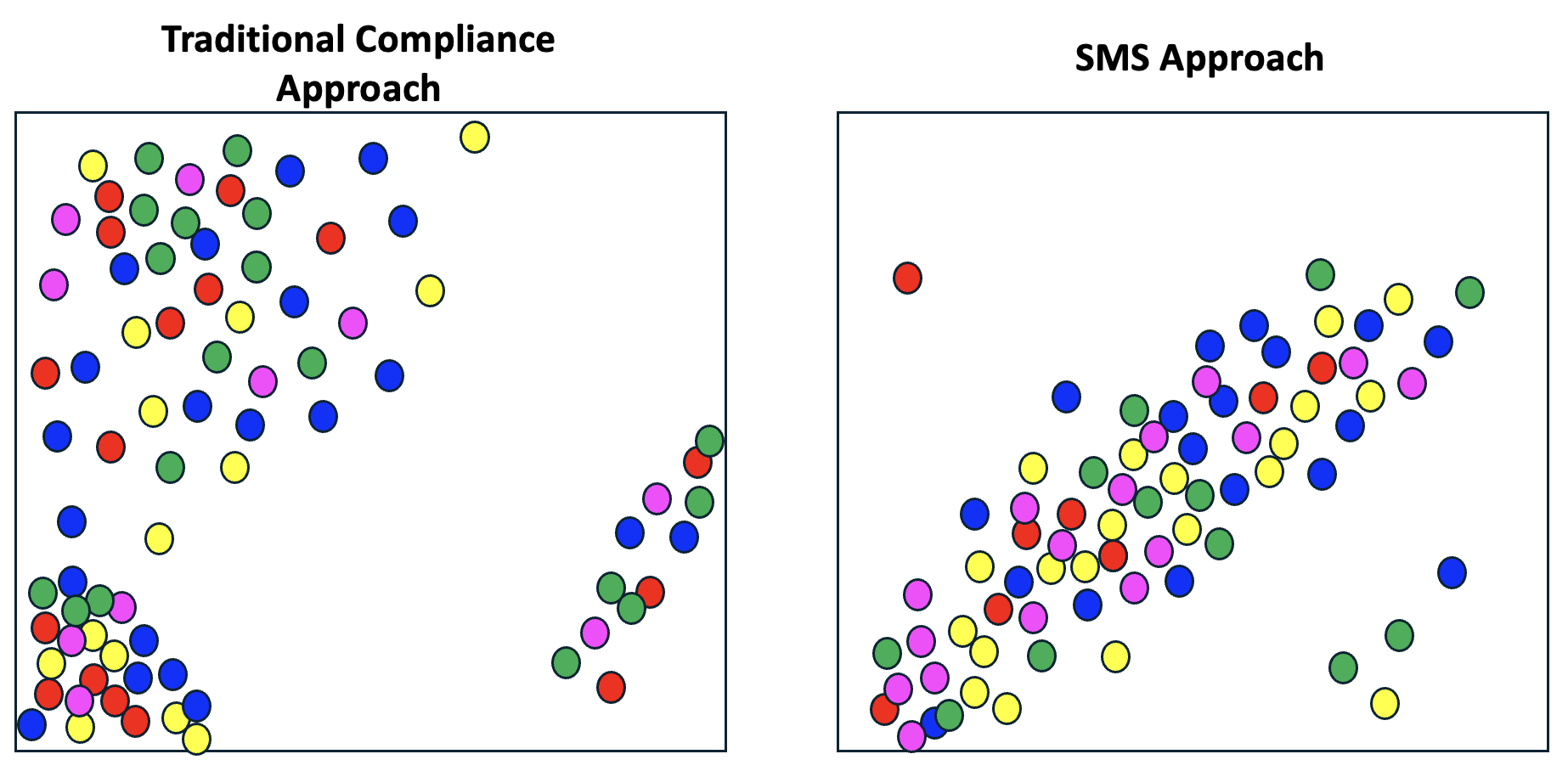One of the top questions I get from "cold callers" or those who have joined SAFTENG and have digested my 400+ articles on Safety Management Systems and all their elements is:
So, what does an SMS do for me and my facility?
The best way to explain this is by an old scatter chart I had done in 1995 by a consulting firm we hired to help us achieve OSHA's VPP STAR level of safety. This and OSHA's PSM standard were my first exposure to a formal and structured SMS approach to managing safety. When the first chart was done, we were in the "compliance stage," where we had the traditional "safety programs" that were "controlled documents," and each control room had its "safety manual," etc. Our programs were solid but individual programs that could stand independently but were not part of a more extensive "risk control" system. There were no metrics on the critical parts of the program(s) and no audit/validation/verification process that each program was functioning as intended and providing the level of safety we assumed it was providing.
Management was a bit concerned when the consultants explained that all of these new activities needed to be taking place; however, we already had a lot of "safety activities" going on. They were not sure how we would be able to manage all these additional activities. So the consultants, along with our Statistical Process Control (SPC) Group (before Six Sigma days), worked with the consultants to plot all of our "safety activities." As you can see, we had a lot of safety activities. But were we getting our money's worth?
Culturally speaking, we rocked it! We scored high on trust and credibility on all corporate climate surveys regarding safety matters. We probably had 80-85% of the hourly workforce participating in safety activities daily. However, we had plateaued in our injury reduction performance, and this was a cause of concern for our plant management and corporate management. It turned out "culture" can only take you so far in safety; at some point, we need to live within an SMS that builds on four (4) pillars of the safety/risk management:
- Identifying Hazards
- Analyzing those hazards with a recognized methodology
- Assigning a (qualitative) risk those hazards pose to people, environment, and business
- Mitigate those risks down to a "tolerable" level
This "structured" approach to safety across the entire plant site allowed us to FOCUS our resources on those things that posed a risk to us and the business. The second chart is what our SMS did for us! Living by these four (4) pillars of an SMS within those two years of alignment, we took our TRIR from around 3 to 1 and below. Lost-time injuries were measured by the millions of hours worked records we set. All the while, the number of incidents reported, investigated, and analyzed, and a CAP put in place, tripled. The BBS observation process went from 95% safe behaviors down to 80% safe, and the 20% unsafe became CONTINUOUS IMPROVEMENT OPPORTUNITIES.
The bottom line is that we had been doing a lot of "activities," but they were NOT aligned with our "risk profile," although the culture was strong. Employees believed we cared. Unfortunately, we were spinning our wheels with a lot of fanfare (e.g., wasting time and resources) - not getting the biggest bang for our time spent on safety. Once the safety committee was trained on how to perform Hazard ID exercises, the safety team trained on Hazard Analysis and Risk Assessment techniques, and everyone on how to build corrective action plans (CAPs) using the Hierarchy of Controls in order to mitigate our risks, it was like unleashing a beast from within!
Of course, we picked all the low-hanging fruit the first year or so, identifying OSHA compliance issues in the plant. But it was progress, and these hazards were being IDENTIFIED by the workers who worked in those environments, and management responded beautifully (VERY KEY to this approach). We had hundreds, if not thousands, of action items in our Corrective Action Plan tracking system (which I stole from the Quality Manager), and this was viewed as OPPORTUNITIES to IMPROVE. We "risk ranked" each CAP to methodically decide which ones needed more/timely attention.
At the end of those 2-3 years, we were a Sub-1 TRIR and a VPP STAR site. And this was back when there were less than 200 STAR sites! When guests came to learn how we did it, it was not me or my team or senior management presenting our SMS approach... it was the chairs of our safety committees, who were front-line supervisors, operators, and maintenance techs, explaining EXACTLY what we did to get from a 3.0 to sub-1 and achieve VPP STAR. The fact that they presented the material spoke volumes about how we managed safety. I am proud to say that three (3) of those hourly employees went to other facilities within the company and became "safety leaders," implementing this same approach. They saw tremendous success everywhere they went.
Here is the visual of what the SMS approach did for us...














